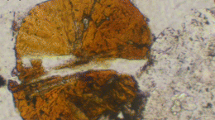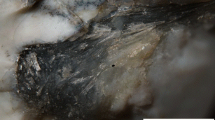Abstract
Kyanoxalite, a new member of the cancrinite group, has been identified in hydrothermally altered hyperalkaline rocks and pegmatites of the Lovozero alkaline pluton, Kola Peninsula, Russia. It was found at Mount Karnasurt (holotype) in association with nepheline, aegirine, sodalite, nosean, albite, lomonosovite, murmanite, fluorapatite, loparite, and natrolite and at Mt. Alluaiv. Kyanoxalite is transparent, ranging in color from bright light blue, greenish light blue and grayish light blue to colorless. The new mineral is brittle, with a perfect cleavage parallel to (100). Mohs hardness is 5–5.5. The measured and calculated densitiesare 2.30(1) and 2.327 g/cm3, respectively. Kyanoxalite is uniaxial, negative, ω = 1.794(1), ɛ = 1.491(1). It is pleochroic from colorless along E to light blue along O. The IR spectrum indicates the presence of oxalate anions C2O 2−4 and water molecules in the absence of CO 2−3 Oxalate ions are confirmed by anion chromatography. The chemical composition (electron microprobe; water was determined by a modified Penfield method and carbon was determined by selective sorption from annealing products) is as follows, wt %: 19.70 Na2O, 1.92 K2O, 0.17 CaO, 27.41 Al2O3, 38.68 SiO2, 0.64 P2O5, 1.05 SO3, 3.23 C2O3, 8.42 H2O; the total is 101.18. The empirical formula (Z = 1) is (Na6.45K0.41Ca0.03)Σ6.89(Si6.53Al5.46O24)[(C2O4)0.455(SO4)0.13(PO4)0.09(OH)0.01]Σ0.68 · 4.74H2O. The idealized formula is Na7(Al5−6Si6−7O24)(C2O4)0.5−1 · 5H2O. Kyanoxalite is hexagonal, the space group is P63, a = 12.744(8), c = 5.213(6) -ray powder diffraction pattern are as follows, [d, [A] (I, %)(hkl)]: 6.39(44) (110), 4.73 (92) (101), 3.679 (72) (300), 3.264 (100) (211, 121), 2.760 (29) (400), 2.618 (36) (002), 2.216, (29) (302, 330). According to the X-ray single crystal study (R = 0.033), two independent C2O4 groups statistically occupy the sites on the axis 63. The new mineral is the first natural silicate with an additional organic anion and is the most hydrated member of the cancrinite group. Its name reflects the color (κɛανgoΣς is light blue in Greek) and the species-forming role of oxalate anions. The holotype is deposited at the Fersman Mineralogical Museum of the Russian Academy of Sciences, Moscow, registration no. 3735/1.
Similar content being viewed by others
References
Anthony, J.W., Bideaux, R.A., Bladh, K.W., and Nichols, M.C., Handbook of Mineralogy, vol.5 Borates, Carbonates, Sulfates, Tuscan: Mineral Data Publishing, 2003.
Bonaccorsi, E. and Merlino, S., Modular Microporous Minerals: Cancrinite-Davyne Group and C-S-H Phases, Rev. Mineral. Geochem., 2005, vol. 57, pp. 241–290.
Bussen, I.V. and Sakharov, A.S., Petrologiya Lovozerskogo shchelochnogo massiva (Petrology of the Lovozero Alkaline Pluton), Leningrad: Nauka, 1972.
Chukanov, N.V., Infrared Spectra of Silicates and Aluminosilicates, Zap. Vseross. Mineral. O-va, 1995, vol. 124, no. 3, pp. 80–85.
Chukanov, N.V., Ermolaeva, V.N., Pekov, I.V., Sokolov, S.V., Nekrasov, A.N., and Sokolova, M.N., Rare-Metal Mineralization Related to Bituminous Substances in the Late Pegmatite Assemblages of the Khibiny and Lovozero Plutons, Novye Dannye o Mineralakh, 2005, vol. 40, pp. 80–95.
Chukanov, N.V., Pekov, I.V., Nekrasov, A.N., Chukanova, V.N., and Naumova, V.S., On the Problem of the Formation and Geochemical Role of Bituminous Matter in Pegmatites of the Khibiny and Lovozero Alkoline Massifs, Kola Peninsula, Russia, Geokhimiya, 2006, vol. 44, no. 7, pp. 774–789 [Geochem. Int. Engl. Transl., 2006, vol. 44, no. 7, pp. 715–728].
Chukanov, N.V., Pekov, I.V., and Ermolaeva, V.N., The Role of Organic Matter in Peralkaline Pegmatites: Comparison of Mineragenetic and Technological Processes, in Minerals As Advanced Materials, Krivovochev, S. Ed., Berlin: Springer, 2008, pp. 221–229.
Deganello, S., Kampf, A.R., and Moore, P.B., The Crystal Structure of Calcium Oxalate Trihydrate: Ca(H2O)3(C2O4), Am. Mineral., 1981, vol. 66, pp. 859–865.
Ermolaeva, V.N., Chukanov, N.V., Pekov, I.V., and Kogarko, L.N., The Geochemical and Genetic Role of Organic Substances in Postmagmatic Derivatives of Alkaline Plutons Zap. Ross. Mineral. O-va, 2008, vol. 137, no. 5, pp. 17–33 [Geol. Ore Deposits (Engl. Transl.), 2009, vol. 51, spec. issue 7, Zapiski Russian Mineral. Soc., 537–541].
Frost, R.L., Yang, J., and Ding, Z., Raman and FTIR Spectroscopy of Natural Oxalates: Implications for the Evidence of Life on Mars, Chinese Sci. Bull., 2003, vol. 48, pp. 1844–1852.
International Tables, C, Prince, E., Ed., the 3rd Edit., 2004, Tables 4.2, 6.8, and 6.1.14
Ito, K. and Bernstein, H.J., The Vibrational Spectra of the Formiate, Acetate and Oxalate Ions, Can. J. Chem., 1956, vol. 34, pp. 170–178.
Khomyakov, A.P., Mineralogiya ul’traagpaitovykh shchelochnykh porod (Mineralogy of Hyperalkaline Rocks), Moscow: Nauka, 1990.
Khomyakov, A.P., Semenov, E.I., Pobedimskaya, E.A., Nadezhina, T.N., and Rastsvetaeva, R.K., Cancrisilite Na7[Al5Si7O24]SO3 · 3H2O, A New Mineral Species of the Cancrinite Family, Zap. Vseross. Mineral. O-va, 1991, vol. 120, no. 6, pp. 80–84.
Lebedev, N.N., Khimiya i tekhnologiya osnovnogo organicheskogo i neftekhimicheskogo sinteza (Chemistry and Technology of Basic Organic and petrochemical Syntheis), Moscow: Khimiya, 1988.
Marks, M., Halama, R., Wenzel, T., and Markl, G., Trace Element Variations in Clinopyroxene and Amphibole from Alkaline to Peralkaline Syenites and Granites: Implications for Mineral-Melt Trace-Element Partitioning, Chem. Geol., 2004, vol. 211, pp. 185–215.
Moiseev, M.M. and Chukanov, N.V., Mineralogy of Alkaline Pegmatites and Hydrothermalites of the Kovdor Pluton, Novye Dannye o Mineralakh, 2006, no. 41, pp. 56–70.
Olysych, L.V., Pekov, I.V., Chukanov, N.V., and Vigasina, M.F., Composition and Typochemical Features of Cancrinite-Group Minerals from the Kovdor Alkaline Pluton, Kola Peninsula, Russia, in Mater. VI Mezhdunar. simpoziuma Mineralogicheskie muzei, (Proceedings of the 6th Intenational Symposium on Mineralogical Museums), St. Petersburg, 2008, pp. 196–199.
Sheldrick, G.M., CHELXS97, Program for the Solution of Crystal Structures, Göttingen: University of Göttingen, 1997a.
Sheldrick, G.M., CHELXS97, Program for the Refinement of Crystal Structures from Diffraction Data, Göttingen: University of Göttingen, 1997b.
Author information
Authors and Affiliations
Corresponding author
Additional information
Original Russian Text ¢ N.V. Chukanov, I.V. Pekov, L.V. Olysych, W. Massa, O.V. Yakubovich, A.E. Zadov, R.K. Rastsvetaeva, M.F. Vigasina, 2009, published in Zapiski RMO (Proceedings of the Russian Mineralogical Society), 2009, No. 6, pp. 18–34.
A new mineral species kyanoxalite and its name are approved by the Commission on New Minerals and Mineral Names, International Mineralogical Association, November 3, 2008, IMA no. 2008-041.
Rights and permissions
About this article
Cite this article
Chukanov, N.V., Pekov, I.V., Olysych, L.V. et al. Kyanoxalite, a new cancrinite-group mineral species with extraframework oxalate anion from the Lovozero alkaline pluton, Kola Peninsula. Geol. Ore Deposits 52, 778–790 (2010). https://doi.org/10.1134/S107570151008009X
Published:
Issue Date:
DOI: https://doi.org/10.1134/S107570151008009X




